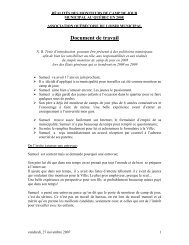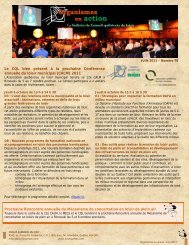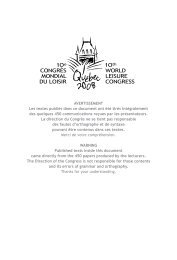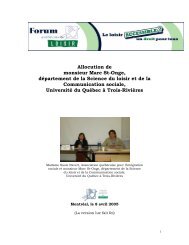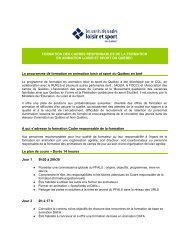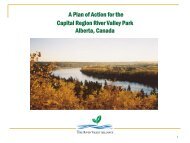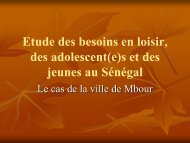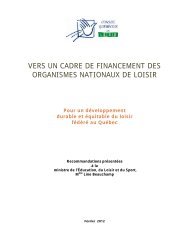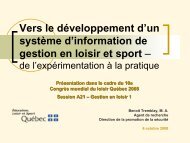Prof M Dhurup
Prof M Dhurup
Prof M Dhurup
Create successful ePaper yourself
Turn your PDF publications into a flip-book with our unique Google optimized e-Paper software.
Introduction• Leisure research – in South Africa – infancy stages• Leisure and recreation research – reflects bleak picture from1980 to 2002 especially in latter years 2001- 2002 only 36reports of a total of 366 research reports emerging from thisperiod (Goslin, 2003)• Yet leisure and recreation is a significant aspect of anindividual’s life.• With the rapid increase in ageing population policy makersneed to pay attention to the ageing population
Focus of Study• Leisure experiences in later life (60-69 years) whoare not in full time employment.• This group of the elderly corresponds to theconventional definition of older people – representsa period of reduced earning (Hunter & May, 2003).
What is Leisure?• Leisure is linked to pleasure; change from work, newexperiences and contacts with friends, passing time, freetime passive activity, enjoyment, fun and relaxation.• Jackson’s (2006) summary of Western and NorthAmerican perspectives of leisure:Leisure → as a measure of time (discretionary time leftover after the completion of work/other obligationsLeisure → as a container of activity (what people chooseto do in their leisure activity)Leisure → in terms of the meaning of leisure (how peopledefine, experience and value leisure, the roles it plays intheir lives)
The Ageing Population• Population in the world ageing at an alarming rate –with adults over 65 years expected to be more thandouble from 2010 (7.7%) to 16% (2050).• Approximately 7.3% of the South African populationwas over 60 years and 0.9% of the population wasover 80 years in 2001.• In South Africa approximately 2.2 million peoplewere aged 65 and over (4.9%) in 2001. 810 000 ofthe 2.2 million were males and 1.4 million werefemales (Statistics South Africa, 2002).
The Elderly (60 –69 years)• The elderly in this period are in an important period intheir lives regarding leisure and family roles.• Changes may be complicated by being empty nested –economic changes – or single-parent households.• During this time-retire from work- become grandparentmaybe responsible for an extended family.• Emotional adjustment – ageing process• Death of a spouse may become a reality
The Elderly in the African Continent• Older people feature as prominent “actors” in the community. They providetraditional and informal health care and are custodians of cultural values.• Child- minders.• Approximately 42% of African households are female headed – and 17% are“granny households” in which the grandmother is the female household headrather than the mother of the children in their care (Hunter & May, 2003).• With Hiv/aids – epidemic – older persons filling – the role of minders for thosesuffering from terminal diseases – take care of day-to-day life experiences –less emphasis on leisure.• In South Africa- majority of the population in age category (60- 69 years) weredenied basic human rights, freedom of movement, and access to basicfacilities- in apartheid years.• Hence the quality of life of the elderly generation is likely to be affected – dueto socio-economic conditions
Research on Leisure• Focused on engagement and disengagement theories• Engagement theory – continuity and change in activitypatterns play important role in adjustment process andold age.• Disengagement theory – the older one gets – the moreone tend to withdraw from society – focus on personalgrowth.• Continuity theory – older people try to use strategies toadapt to changes – used as a coping strategy
Purpose of the Study• Verify differences in the types of leisureparticipation – those living in urban and semiurban areas.• Study also examines whether the elderly arediverse in terms of gender, populationcategories, life satisfaction, stress and sense ofsecurity.
Qualitative ResearchResearch DesignQualitative Study20 in-depth InterviewResults wereContent analyzed
Research DesignQuantitative Study• Convenience sample of 60• Respondents were officially retired – but those stillworking excluded from the sample.• Structured questionnaire• Pre-tested with a sample of 10 respondents• Leisure engagement divided into six sections (broadactivities)Fitness and health relatedWater basedNatural environmentTravelOutdoorGeneral activities
Analysis of Results<strong>Prof</strong>ile of RespondentsGENDERMARITAL STATUSMale(%)Female( %)Single(%)Divorced(%)Separated(%)Married(%)Widowed(%)35(58%)25(42%)11(19%)2(3%)4(7%)26(43%)17(28%)
Population GroupsAfrican White OtherNO % NO % NO %40 67 15 25 5 8
Language GroupsSouthernSothoAfrikaansEnglishNO % NO % NO %23 38 10 17 8 13
Educational LevelsDegree Matric Grade7-11Primary /noEducationNO % NO % NO % NO %23 38 15 25 12 20 10 17
Leisure ParticipationACTIVITYCode(internal)TotalParticipation(Yes)Total%(Yes)NonPart(no)FITNESS AND HEALTH RELATED ACTIVITIESNonpart%(no)Male(yes)Male%(yes)Female(yes)Cycling FH1 12 20.00 48 80.00 9 26 3 12Golf FH2 11 18.33 49 81.67 10 29 1 4Racquet sports FH3 6 10.00 54 90.00 4 11 2 8Bowls FH4 6 10.00 54 90.00 4 11 2 8Climbing/jumping FH5 6 10.00 54 90.00 4 11 2 8Jogging/walking FH6 44 73.33 16 26.67 28 80 16 64Fitness programmes FH7 22 36.67 38 63.33 13 37 9 36WATER BASED SPORTSSwimming/diving WS1 9 15.00 51 85.00 7 20 2 8Sailing/canoeing WS2 9 15.00 51 85.00 9 26 0 0Power generated boating WS3 9 15.00 51 85.00 6 17 3 12%(yes)
Leisure ParticipationACTIVITYCode(internal)TotalParticipation(Yes)Total%(Yes)NonPart(no)Nonpart%(no)Male(yes)Male%(yes)Female(yes)%(yes)NATURAL ENVIRONMENTAL ACTIVITIESHunting (sport) NE1 19 31.67 41 68.33 15 43 4 16Fishing (sport) NE2 15 25.00 45 75.00 20 57 7 28Bird watching NE3 15 25.00 45 75.00 9 26 6 24Overseas travel forvacationTravel/vacation/neighbouringcountriesTRAVELTA1 12 20.00 48 80.00 7 20 5 20TA2 27 45.00 33 55.00 18 51 7 28Social visiting TA4 50 83.33 10 16.67 27 77 23 92Travel for performingarts/sportTA5 31 51.67 29 48.33 23 66 8 32
Leisure ParticipationACTIVITYCode(internal)TotalParticipation(Yes)Total%(Yes)NonPart(no)OUTDOOR FUN ACTIVITIESNonpart%(no)Male(yes)Male%(yes)Female(yes)Gardening OF1 43 71.67 17 28.33 26 74 17 28Barbeque OF2 36 60.00 24 40.00 23 66 13 52Visiting parks/gardens OF3 38 63.33 22 36.67 25 71 13 52Small scale farming OF4 33 55.00 27 45.00 20 57 13 52%(yes)
ACTIVITYLeisure ParticipationCode(internal)TotalParticipation(Yes)Total%(Yes)NonPart(no)GENERAL RECREATIONAL ACTIVITIESNonpart%(no)Male(yes)Male%(yes)Female(yes)Watch TV/movies GR1 57 95.00 3 5.00 33 94 24 96Play cardgames/board games%(yes)GR2 28 46.67 32 53.33 19 54 9 36Crafts and hobbies GR3 23 38.33 35 61.67 13 37 10 40Reading GR4 45 75.00 15 25.00 27 77 18 72Church/place ofworshipCommunitywork/volunteeringConsumingalcohol/gamblingGR5 48 80.00 12 20.00 26 74 22 88GR6 21 35.00 39 65.00 13 37 8 32GR7 17 28.33 43 71.67 11 31 6 24Eat out at restaurants GR8 33 55.00 27 45.00 23 66 10 40Shopping GR9 42 70.00 18 30.00 22 63 20 80Taking care ofchildren/grandchildrenGR10 42 70.00 18 30.00 21 60 21 84Idling/doing nothing GR11 16 26.67 44 73.33 10 29 6 24Playing indigenousgamesGR12 17 28.33 43 71.67 12 34 5 20Story telling GR13 27 45.00 33 55.00 12 34 15 60
Leisure Participation byPopulation GroupsPOPULATION GROUP/ACTIVITY AFRICAN WHITE OTHERFITNESS AND HEALTH RELATED ACTIVITIESCycling 2 8 2Golf 0 11 0Racquet sports 1 4 1Bowls 0 6 0Climbing/jumping 0 6 0Jogging/walking 30 14 0Fitness programmes 8 12 2WATER BASED SPORTSSwimming/diving 1 8 0Sailing/canoeing 0 9 0Power generated boating 0 9 0
Leisure Participation byPopulation GroupsPOPULATION GROUP/ACTIVITY AFRICAN WHITE OTHERNATURAL ENVIRONMENTAL ACTIVITIESHunting (sport) 6 13 0Fishing (sport) 10 5 0Bird watching 1 14 0TRAVELOverseas travel for vacation 0 12 0Travel/vacation/neighbouring countries 12 15 0Social visiting 31 15 4Travel for performing arts/sport 19 12 0OUTDOOR FUN ACTIVITIESGardening 26 15 2Barbeque 19 15 2Visiting parks/gardens 24 14 0Small scale farming 23 10 0
Leisure Participation byPopulation GroupsPOPULATION GROUP/ACTIVITY AFRICAN WHITE OTHERGENERAL RECREATIONAL ACTIVITIESWatch TV/movies 37 15 5Play card games/board games 15 12 1Crafts and hobbies 10 12 1Reading 25 15 5Church/place of worship 30 14 4Community work/volunteering 10 9 2Consuming alcohol/gambling 10 7 0Eat out at restaurants 15 15 3Shopping 26 14 2Taking care of children/grandchildren 36 4 2Idling/doing nothing 8 6 2Playing indigenous games 17 0 0Story telling 26 1 0
Participation in Health & FitnessActivitiesAmong the fitness and health related categories,jogging, walking and distance running seem to bethe popular activity (n =44; 73%) among bothurban and semi urban elderly followed by fitnessprogrammes (n = 22%) through affiliation withhealth and fitness clubs.
Participation in Water BasedSports• Water based sport such as swimming, sailing,canoeing, and power boating do not featureprominently among the leisure activities of theelderly.• Only (n= 9; 15%) of the elderly reportedparticipation in such activities.
Participation in NaturalEnvironmental ActivitiesSimilarly natural environmental activities such ashunting as sport, fishing and bird watching are theleisure domain of only a few (n =19; 32%; n =15;25%) respondents
Participation in Travel Activities• With reference to travel activities, social visitingto meet friends, relatives in other towns, cities orprovinces seem to be high on the agenda (n=50; 83%) of the elderly as a form of leisureactivity.• Approximately (n =31; 52%) of the elderly preferto travel in order to watch performing arts,musicals, spectator-related sports such assoccer and rugby.
Participation in Outdoor FunActivitiesThe elderly also seem to possess an enormouspropensity to consumer outdoor fun activities suchas gardening (n =43; 73%), barbeque (braai) (n=36; 60%) and visits to parks and gardens (n =38;63%) especially with their children andgrandchildren.
General Recreational Activities• An analysis of the general activities howeverpresents a mixed type of leisure participation.• Of the various general leisure activities majority(n=57; 95%) of the elderly spend their leisuretime watching television or going to a movietheatre. Reading (n =45; 75%), church going orother places of worship (n =48; 80%), shopping(n =42; 70%) and taking care of children orgrandchildren (n = 42; 70%) also seem tooccupy the elderly leisure time.
Life Satisfaction, Stress & Security• Of concern majority of the elderly (n=40; 67%)were either dissatisfied or very dissatisfied only(n=7; 12%) being satisfied, and a fair proportion(n=13; 22%) were neutral in their responses withlife during this stage of their lives.• A similar pattern emerged with regard to level ofstress and sense of security where majority ofthe elderly (n=27; 45%) and (n=31; 52%)respectively were either highly stressed or highlyinsecure.
Discussion of Results 1• Story telling seems to be popular amongwomen. This feature a particularly true amongthe African communities especially when takingcare of children and grandchildren.
Discussion of Results 2• Both gender groups preferred travel. However thesetypes of travel were limited to social visits to meet friendsand relatives.• Men were more inclined to sports and outdoor funactivities and women were more inclined to indoor typeof activities.• Gardening, visits to parks and barbeque were frequentlyundertaken by men and to a less extend by women.• Male and female respondents also show a propensity toparticipate religious services and religious gathering.
Discussion of Results 3• Shopping emerged as a domain of both men andwomen.• Shopping is viewed as self-entertainment especially visitsto shopping malls. Research evidence (Moschis, Curasi &Bellenger, 2004; Baben et Babin& Darden & Griffin1994;Nicholis, Li; Mandokovic, Roslow & Kranendonk, 2000)supports the notion that people often see shopping as aform of diversion, i.e. getting away from the routine ofeveryday life with diversion as a form of relaxation, whichcould be extended into self-gratification by spendingmoney on oneself.
Life Satisfaction• The high incidence of life dissatisfaction reported by theelderly is certainly a cause for concern.• This feeling may be due to fact that this group of theelderly which constitutes mainly the African populationhave grown up in the years of suppression duringapartheid with very little provision of leisure facilitiespresent in their communities.• With democracy in its infancy stages this feeling ofhelplessness and hopelessness may take a longer time tobear the fruits of their sacrifices in order to fullyappreciate the meaning of leisure and leisureparticipation.
Life Satisfaction• In addition excerpts from the in-depth interviews revealedthe following: “in our communities we do not havesufficient money and the wages that we earned was toolittle to take care of our family…” “…recreation facilitiesare lacking in our communities”, “the only recreation wehave is to be with our children and take care of them”.• This could also be a reason for the lack of meaningfulparticipation in leisure activities. Studies undertaken byWong (2003: 309) found that the elderly with higher incomeor those who were financially stable are more satisfied withlife than those with lower incomes.• During this stage of their life cycle the elderly oftenundergoes major lifestyle changes which haveconsiderable impact on their life satisfaction. For example,lower satisfaction levels registered by the elderly could belargely due to adjustments problems after retirement suchas the ‘empty nest’ syndrome and loss of regular income.
Stress & Security• The low levels of satisfaction with life also seem to belinked to the high levels of stress and security of theelderly.• Stress and insecurity seem to be more prevalent againamong the African population. This sense of insecurityand high levels of stress seem to be linked to financialinsecurity, health problems and lack of support fromfamily and state departments during their golden years oftheir lives.• Excerpts from in-depth interviews revealed the following“my pension that I receive is too small to take care of myfamily” “… I have to pay for groceries, electricity and bythe end of the month I have no money”.
Recommendations• Although there are limits to what thegovernment or voluntary welfare organizationscould implement to influence the healthconditions of the elderly, these authorities couldassist the elderly in their adjustment afterretirement by providing appropriate socialnetworks and community services as well aspre-retirement public education on financialsecurity, planning and investments.
Recommendations• Greater involvement in varied types of leisure activities isencouraged. Silverstein and Parker’s (2002) ten yearlongitudinal study found that older adults who becameactive in a greater number of activity categories weremore likely to report that their lives had improvedcompared to those older adults who participated infewer activity categories. These results were particularlystrong for those older adults who had undergone majorlife changes such as becoming widowed, experiencingdeclines in physical functioning or having low contactwith family.
Recommendations• While limited financial resources were cited as aconstraint to participation in physical activity suchconstraints may be circumvented by this group of elderlyby undertaking more home-based leisure activities. Kellyand Ross (1989) reported that home-based activities arean important contributor to life satisfaction among theolder generation.• Men and women reported participation in religiousactivities. Religious and spiritual organizations also canprovide an important space for social interactions andnetworking among older adults.
Recommendations• Other forms of volunteering may also provideopportunities for older adults to acquire andpractice new skill, hobbies and in the processmake social contacts and enhance socialintegration in order to maintain a sense ofusefulness, purpose and structure in life (Menec,2003; Wu, Tang, Yan, 2005).
Recommendations• Differences emerged in leisure behaviour urban andsemi-urban groups (Vanderbijlpark – primarily White andSebokeng – primarly African)• More activities to participate in Vanderbijlparkcompared to Sebokeng.• Depth interviews reflected different types of barriers toleisure time activity• Those in semi-urban areas cited security, finance,transport, facilities as some of the barriers. Disparities inresource, infrastructure allocation by the LocalGovernment needs to be addressed.
Limitations• Although this study provides empirical results of a SouthAfrican elderly market in the Vaal triangle, the study mayhave limitations in generalizing to other regions andcountries.• They may be some differences in leisure activities of theelderly in other regions of the country or nations.• Another limitation is the sampling framework. Whilst everyeffort was made to randomize the collection of data thequality of data in this research may be vulnerable due tothe use of convenience sampling method and thesample size.
Implication for Future Research• Whilst the research has focused on the elderly; thisgeneration (elderly) has no doubt generated a richheritage of a way forward to enhancing the “self worth“of those who are yet to enter into this phase of their lives.• Research on different age categories and leisureactivities are therefore encouraged.• Research on leisure activities within a South Africancontext on cultural diversity may also advance ourunderstanding of leisure participation.



